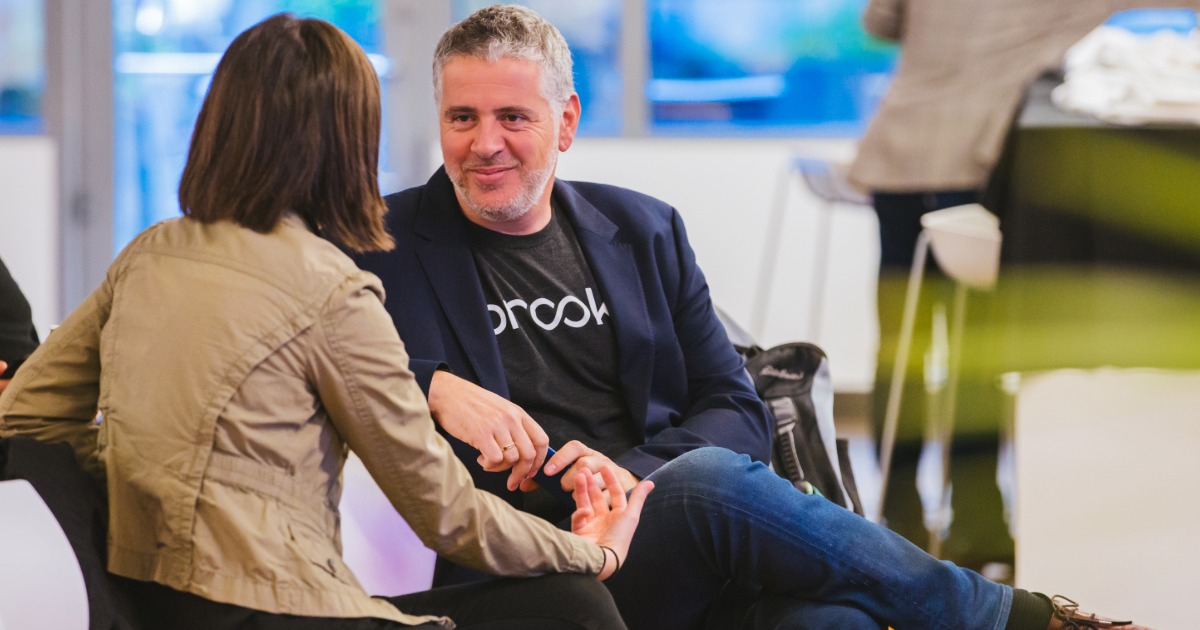In part two of the Healthcare IT News Q&A with Micky Tripathi, he lays out the ways interoperability can finally be brought to fruition in the U.S. over the coming decade. Hint: the federal government and the private sector each have big jobs to do.
[See also: Interoperability: supply and demand]
In our chat Wednesday with Tripathi, CEO of the Massachusetts eHealth Collaborative and co-chair of the joint HIT Policy and Standards Committee's JASON Task Force, he offered some perspective on how and why interoperability has historically been such a problem for healthcare – and discussed lessons that might be drawn from other industries that were able to make it happen.
With the Office of the National Coordinator for Health IT now redoubling its efforts to make seamless, wide-reaching data exchange a reality within the next 10 years, he gives some further thoughts on how it all might play out.
[See also: Taking out interoperability hurdles]
 Q: What role can the government play in guiding this journey? Obviously, the initial goals of HITECH and meaningful use have been a success: EHRs are now commonplace. But that was accomplished with the help of $27 billion. Now that that money has mostly been paid out, how much can the feds really do to spur interoperability? Is it up to ONC to just use its bully pulpit to encourage the private sector to act?
Q: What role can the government play in guiding this journey? Obviously, the initial goals of HITECH and meaningful use have been a success: EHRs are now commonplace. But that was accomplished with the help of $27 billion. Now that that money has mostly been paid out, how much can the feds really do to spur interoperability? Is it up to ONC to just use its bully pulpit to encourage the private sector to act?
A: That's a fantastic question. ONC is now in the process of creating this interoperability roadmap that you may have seen – they put out a vision statement and have a three-, six- and 10-year vision, and they are now in the process of fleshing that out, and they're going to be releasing that on a schedule where they're going to be asking the federal advisory committees, the policy committee and standards committees, (for input) in mid-October and they're going to be releasing their next iteration of that and asking for comments. And then I think the idea is that by January they'll offer a more fully-blown out roadmap.
They've had different input from different groups and different experts, and one of the things that came up at one of those recent roundtables was the very question you're asking: What role does ONC see itself playing in this? Because if you look in the three- and the six- and the 10-year visions, it's like, OK, that's great, as a vision: By year 10 we want to have a learning healthcare system.' Well, let's get an operational definition of that.
But then the question is, who's doing that? Does that mean ONC is going to go back to Congress and ask for $100 billion for that? I don't think that's what they're saying. And I think they're starting to give greater thought to all of the various levers they have.
So bully pulpit, as you mentioned, is one of them, and I think there's something to that. But there's also sort of a wide range of levers, and each of them on their own couldn't do anything, but if ONC could play a role in orchestrating those, it could have, I would argue, at least as powerful an effect – if not an even more powerful effect than meaningful use.
For example, payment models. As we know, most of the accountable care activity going on in the country these days is pioneer ACOs and Medicare Shared Savings program. Starting to build more and more into those programs – reimbursement based on activities that you can only do with interoperability is the kind of thing that creates more of an incentive for people to just go out and demand interoperability. And that's pretty powerful.
Even in the fee-for-service area – you may have seen just the other week that CMS said they will start now, even for people who are on fee-for-service models, that they will start paying PCPs for care management activities. Whereas before, the joke among physicians was that, 'CMS will pay me to clip someone's toes, but if I spend half an hour thinking about a care plan for a complex diabetic patient who also has congestive heart failure and other comorbidities, I get paid zero.' Well, now CMS is agreeing that there's something perverse about that and will actually pay for care management activities.
So that, then, creates an incentive for people, now that they're being paid for things like that, to invest in systems that will get me the information so they can do care management activities more effectively.
There's those kinds of levers, there's levers related to the different regulatory authority they have. CLIA – the lab certification program that CMS has – they might be able to start implicating the lab certification process, saying, 'Oh, by the way, lab, not only are we going to come in and certify you based on good manufacturing practices within your lab, we're also going to talk about, are you doing lab codification according to LOINC, which is a national standard.
Or talk about the DoD and the VA. Maybe that's a lost cause (laughs), but on the other hand they are very powerful and they spend a lot of money on care delivery. If you can start to align some of those things, that could be very powerful in the market.
Nursing homes. Every nursing home and home healthcare agency in the U.S. has to submit OASIS forms (Outcome and Assessment Information Set) to Medicaid. Those are completely non-standardized and not aligned with what meaningful use and the standards we have for interoperability require, in the way of C-CDAs and XML. If CMS just started to say, all that stuff has to be reported using the interoperability infrastructure and tools we've given you through meaningful use, again, you could start to see nursing homes investing in EHRs that can do that now in order to be a provider on the Medicare network.
We just recently saw a presentation from ONC where they're starting to inventory all those levers, and starting to say, 'Now how do we put those into buckets and think about how we can orchestrate those in a coherent way.' To me, that's incredibly powerful.
Q: On the market side, what do you make of organizations like the CommonWell Health Alliance?
A: To me, that's a welcome and necessary development. In meaningful use Stage 1 there was something like 3,000 vendors or something, and then you narrow the set and now it's a thousand, or whatever it is. I could see that this is going to evolve in the market. What might be the way it could can play in the U.S. It'd different than Denmark, where the government is very strong in that economy. They can dictate the terms and then everyone has to follow. Among industrialized countries, the U.S. has the weakest federal government of all of them. So the government is not going to be able to do that much with this as we move forward.
In other markets you start to see coalitions form in the industry, where they themselves recognize the need to do this. I can imagine a world where you have Epic – huge gorilla – and eClinicalWorks, another big gorilla, and then they have their own vendor-specific networks where a lot of health information exchange actually happens within their networks. There's a ton of interoperability that happens there.
And then you have CommonWell, which is a group of vendors getting together. In some ways it's one of the negative developments of competition, in a way, because who are the companies in CommonWell? Well, it's everyone who has an interest in making sure Epic and eClinicalWorks don't conquer the world, right? That would be the game theoretic way of looking at that.
But the other thing you could imagine, though, is fine, whatever the motivations, what if we start to see this grow. And Epic continues to grow. They have a network, eClinicalWorks has a network. CommonWell brings together six, 10, maybe 15 vendors under their umbrella. And at some point, in the not too distant future, I have three networks and I can cover 70 percent of the market if I could get these three networks to talk to each other. Maybe the federal government helps facilitate that, or maybe on their own, they just decide, 'Well, we've done all we can do on our own networks.'
Like the banks, where they had the ATM networks – there was Cirrus, there was Yankee and there was NYCE – they had a bunch of those networks but at some point the banks got together and said 'It makes more sense for us to get these networks to talk to each other now, because we're not going to get anymore market penetration: I can't steal anymore from you, you can't steal anymore from me, so we have an interest in getting our networks to talk to each other.
I could imagine that happening. And maybe that's going to be a solution at least one part of our interoperability dilemma.
The good thing about that happening from the vendor side is that if you look at what CommonWell is doing, they're deeply embedding that stuff into their (EHR) workflows. The problem, as we've discovered, with some of these certification processes is, as well intentioned as they are, if you have a requirements process that comes from the outside – and in this case I'll just say the outside is CMS, as a large purchaser, that defines requirements with all best intents and all the best input they can get, it's almost certainly going to be wrong on some level because the market is so complicated.
And so you have things like Direct, or whatever it is, that get foisted on the industry without a whole lot … it's sort of a novel thing that gets introduced and then doesn't get incorporated: 'It came from the outside, and I feel like I have to do it, but I'm not sure if my customers want it. I'll do it because I have to, but am I going to fully bake it into the way my software works? Maybe not.'
The good thing about CommonWell and these others is that it's more from the bottom up: 'I'm going to base this on the need that I'm seeing now from the providers, who are saying I want this fully integrated and easy to use within my application.'
Its a really useful development because it helps to jumpstart this process innovation that, with Direct, we're sort of struggling with: we have the technology, but it's not yet baked into the workflow.
Q: What do you see ahead for health information exchanges – the nouns, not the verb? A lot of them aren't reaching the critical mass many thought they would, and are having trouble building a vision for long-term viability.
A: Yeah. (Sighs.) I was one of the ones who had higher hopes for them than our experience has borne out. My personal view is that most of them will probably go away. And I don't think that's a bad thing. We live in a market economy, and they're market actors just like any other market actors. And if they're not delivering value people are willing to pay for, they shouldn't try to hang around.
The bad news for them is that increasingly vendors are fueling the demand from providers to come up with health information exchange solutions. And they're not saying, 'I'll outsource all this to an HIE.' They're saying, 'If my providers are demanding health information exchange, I'm going to come up with health information exchange solutions. But I'm not going to assume there's going to be a nationwide network of health information exchange organizations that I'm going to have to rely on in order to interoperate with other providers or vendor systems in this community.'
That's how a CommonWell comes up. If you look at what they do, well, they don't do anything different than any of the health information organizations claim to want to do. But they themselves are kind of feeling like, 'We want to do it in a way that we can control and rely on for these critical functions, and not rely on these other organizations that may or may not be there, or are not uniform across the country. I've got the Indiana HIE, that's great, but I've got a national customer base, and I can't build everything according to what Indianapolis does.'
But that's not to say they're all going to go away. There are many places where they're completely sustainable. The Massachusetts Statewide HIE is completely sustainable and will keep going. Indianapolis, Cincinnati, Rhode Island, Albany, Buffalo, Rochester – all of those have fee-based customers who are paying to keep them going.
Q: Where do you think we'll be with all this 10 years from now?
A: I told you that 10 years ago I thought we'd be further along than we are now (laughs), but I'm pretty confident that 10 years from now – I think it's going to take six to 10 years for us to get to somewhere of the proximity of the JASON vision. Which is to say that we have something that approximates data liquidity, across systems, first and foremost to improve patient care, and then, secondarily, to start to be able to aggregate data, at more than just a local level, to do research and population health.
I guess I'd just reflect on Bill Gates' quote, by now it's almost a cliche, but we always overestimate the effect of technology in five years and we underestimate the effect it's going to have in 10 years.
I suspect that's probably true if you take it in 10 and 10 blocks – that we overestimated how much we'd be able to accomplish in the 10 years since David Brailer and ONC was established in 2004. But I think now that we've got a foundation of EHRs, and we've learned a ton, and demand is genuinely there now, from the bottom up, in a way that wasn't there in the prior 10 years, I think we're going to be able to accomplish a tremendous amount over the next 10 years.
That's what I would hope: that we see ubiquitous nationwide networks – they could be independent networks, but they talk to each other – and the ability to have information aggregation in a way that allows us to get a better perspective on the pulse of where healthcare is: where are the hotspots, and how can we do better.
And then, finally, that will also enable patients to do much more than they can do right now, and think of healthcare as just like any other thing they do in their lives, like Facebook or Amazon. I think that's a reasonable expectation for us to have in 10 years.


